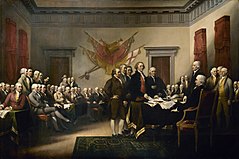 Yesterday, the United States of America celebrated its Independence. Representatives of the original Thirteen Colonies came together 242 years ago to sever their ties with the British Crown and establish their own government. The Declaration of Independence was the result. The document outlined the core beliefs of a new nation:
Yesterday, the United States of America celebrated its Independence. Representatives of the original Thirteen Colonies came together 242 years ago to sever their ties with the British Crown and establish their own government. The Declaration of Independence was the result. The document outlined the core beliefs of a new nation:
“We hold these truths to be self-evident, that all men are created equal, that they are endowed by their Creator with certain unalienable Rights, that among these are Life, Liberty and the pursuit of Happiness.”1
It also provided a list of 27 grievances against the King of Great Britain:
“To prove this, let Facts be submitted to a candid world.”2
Many of the grievances listed can be reframed to represent the frustrations employees have with their companies and their leaders. Let’s consider six of the grievances in the Declaration of Independence in relation to current workplace issues.
“He has forbidden his Governors to pass Laws of immediate and pressing importance, unless suspended in their operation till his Assent should be obtained; and when so suspended, he has utterly neglected to attend to them.”3
“He has made Judges dependent on his Will alone, for the tenure of their offices, and the amount and payment of their salaries.” 4
“He has called together legislative bodies at places unusual, uncomfortable, and distant from the depository of their public Records, for the sole purpose of fatiguing them into compliance with his measures.” 5
Each of the three grievances above relate to autonomy.
“Autonomy is people’s need to perceive that they have choices, that what they are doing is of their own volition, and that they are the source of their own actions. The way managers and leaders frame information and situations either promotes the likelihood that a person will perceive autonomy or undermines it.6”
“You want your staff to live up to their full potential. Telling them what to do, how to do it, and when to do it “because you said so” is not a recipe for long-term success. Yes, you will get short-term results, but this style of leadership is not sustainable. Ideally, you want the members of your team to see that the goals they are pursuing have real value. In fact, you want them to make the goals their own—and with good reason. Studies show that the greatest motivation and personal satisfaction comes from those goals that we choose for ourselves. Self-chosen goals create a specific kind of motivation called intrinsic motivation – the desire to do something for its own sake.2 When people are intrinsically motivated, they find greater enjoyment in what they are doing, they are more engaged with their work, and they have higher job satisfaction. They are also more persistent in the face of difficulty. In other words, they perform better and exercise their potential. You’ll also discover an added benefit: higher retention rates.”7
“He has called together legislative bodies at places unusual, uncomfortable, and distant from the depository of their public Records, for the sole purpose of fatiguing them into compliance with his measures.”8
“Workplace Bureaucracy can leave your company stagnant & demotivated. As a leader, a manager and an individual contributor, you should be looking to create a balance between creativity and consistency. Each one of us has the responsibility to improve our work environment.”9
“So how should employees, managers, and business leaders balance creativity vs. consistency? The answer itself is a process…called continuous improvement.”10
“The result of this balanced approach to creativity and structure is a forward moving, customer centric organization with improved employee moral, stable, efficient processes used by all employees, and a raised bar of performance. By encouraging your best employees to share their insights, and incorporating those ideas into your overall processes, you will be sharing best practice among your entire workforce.”11
“He has dissolved Representative Houses repeatedly, for opposing with manly firmness his invasions on the rights of the people.”12
“While conflicting viewpoints can be difficult to hear, often they’re exactly what you need. Striving to create a culture where new ideas and different opinions are encouraged will result in a workplace that’s thriving and growing — one where innovation becomes second nature.”13
“He has refused for a long time, after such dissolutions, to cause others to be elected; whereby the Legislative powers, incapable of Annihilation, have returned to the People at large for their exercise; the State remaining in the mean time exposed to all the dangers of invasion from without, and convulsions within.”14
“Positions which remain vacant for months impact not only productivity but staff morale as employees are forced to carry out additional responsibilities to cover the gap in skills. Pressure on your existing teams affects employee engagement and retention levels. Vacancies in critical positions means that some vital projects may be delayed or unfulfilled because your company simply doesn’t have the skills available in-house to meet demand. In the worst case scenario, your customers will experience the effect of unfilled positions with a subsequent impact on customer service.”15
“He has endeavoured to prevent the population of these States; for that purpose obstructing the Laws for Naturalization of Foreigners; refusing to pass others to encourage their migrations hither, and raising the conditions of new Appropriations of Lands.”16
It’s about the employee experience. Are your employees overworked? Are you understaffed. Does it really matter where or when your employees work?
“The employee experience encapsulates all that people encounter, observe or feel over the course of their employee journey at an organization. It’s an expansive view of the relationship between the individual and the organization, starting with the application process and continuing through to the day the individual exits the business and even beyond to when they join the organization’s alumni.”17
“There are a lot of things that can go into creating an employee experience but the good news is that every single company regardless of their industry, geography, or size, only need to focus on three things. Every employee experience is comprised of three environments: the physical environment, the cultural environment, and the technological environment.”18
Oddly enough, the employee engagement surveys companies administer provide a list of grievances against the company. It’s how the company responds to those grievances and how they treat their employees (hint: avoid “tyranny and oppression”) that ultimately impacts whether or not employees become independent (autonomous) in their work or declare their independence from the company.
What are your thoughts on these grievances and their application to employee experience? What other grievances in the Declaration of Independence can you equate to current workplace experiences?
1 “Declaration of Independence: A Transcription.” National Archives and Records Administration, National Archives and Records Administration, www.archives.gov/founding-docs/declaration-transcript.
2 Ibid.
3 Ibid.
4 Ibid.
5 Ibid.
6 Susan Fowler, “What Maslow’s Hierarchy Won’t Tell You about Motivation,”Harvard Business Review, November 26, 2014. https://hbr.org/2014/11/what-maslows-hierarchy-wont-tell-you-about-motivation.
7 Cheverie, Joan. “Why Autonomy Is Important for Peak Performance.” EDUCAUSE Review, EDUCAUSE, 8 June 2015, er.educause.edu/blogs/2015/6/why-autonomy-is-important-for-peak-performance.
8 “Declaration of Independence: A Transcription.” National Archives and Records Administration, National Archives and Records Administration, www.archives.gov/founding-docs/declaration-transcript.
9 Woods, Lisa. “Workplace Bureaucracy – Learn to Break Through the Red Tape!” Managing Americans, ManagingAmericans.com, LLC, 5 Sept. 2012, www.managingamericans.com/BlogFeed/Operations/Workplace-Bureaucracy-Learn-to-Break-Through-the-Red-Tape.htm.
10 Ibid.
11 Ibid.
12 “Declaration of Independence: A Transcription.” National Archives and Records Administration, National Archives and Records Administration, www.archives.gov/founding-docs/declaration-transcript.
13 Hayden, Brenton. “6 Reasons Why ‘My Way or the Highway’ Management Doesn’t Work Anymore.” Entrepreneur, Entrepreneur Media, Inc, 12 Nov. 2015, www.entrepreneur.com/article/252270.
14 “Declaration of Independence: A Transcription.” National Archives and Records Administration, National Archives and Records Administration, www.archives.gov/founding-docs/declaration-transcript.
15 “Advorto.” Recruitment Management Software and Applicant Tracking System, Advorto, www.advorto.com/en-gb/resources/recruitment-articles/talent-acquisition-why-slow-hiring-is-bad-for-business.aspx.
16 “Declaration of Independence: A Transcription.” National Archives and Records Administration, National Archives and Records Administration, www.archives.gov/founding-docs/declaration-transcript.
17 Le Gallez, Katie. “What Is Employee Experience?” Culture Amp Blog, Culture Amp Pty Ltd, blog.cultureamp.com/what-is-employee-experience.
18 Morgan, Jacob. “The Three Environments That Create Every Employee Experience.” Forbes, Forbes Magazine, 16 Dec. 2015, www.forbes.com/sites/jacobmorgan/2015/12/15/the-three-environments-that-create-every-employee-experience/#6c98364666c6.
Let’s Engage!
I’m Agent in Engagement Simpson…Gregory F Simpson.
Employee engagement is a critical mission. I hope I can count on your help! Subscribe to the RSS Feed to receive the latest intelligence/insights and/or register to make entries in the comments log.
 You can follow me @agtinengagement.
You can follow me @agtinengagement.
Email me at g…@a…t.com.
Connect via LinkedIn at LinkedIn.com/in/GregoryFSimpson.
Learn more about me at gregoryfsimpson.com.
P.S. First contact? Welcome to the Agent In Engagement community. Explore and join fellow employee engagement operatives in targeting a known thief – alias: Disengagement. Together we can bring this thief to justice and make the world a better place for all companies and their employees.
Other recent Agent in Engagement data/reports by Agent Gregory F Simpson:
- Employee Engagement Intelligence Briefing: 2018.06.25 – 2018.06.29
- Veteran Operative Employee Engagement Insights: 2018.06.25 – 2018.06.29
- Top Employee Engagement-Related Articles of June 2018
- The March 2018 – NYC Pride and Identifying Diverse and Inclusive Workplaces
- 5 Recent TED Talks to Help Frontline Managers Enhance Employee Experience
- 10 Important Phrases to Improve Employee Engagement
- Top Employee Engagement-Related Articles of May 2018